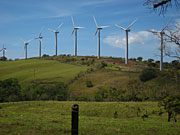- Number 353 |
- January 2, 2012
Lawrence Livermore ramps up wind energy research

Vestas V47 machines at the
Tejona Wind Farm in Costa Rica.
Photo courtesy of Andrew Clark.
As the percentage of wind energy contributing to the power grid continues to increase, the variable nature of wind can make it difficult to keep the generation and the load balanced.
But recent work by DOE's Lawrence Livermore National Laboratory, in conjunction with AWS Truepower, may help this balance through a project that alerts control room operators of wind conditions and energy forecasts so they can make well-informed scheduling decisions. This is especially important during extreme events, such as ramps, when there is a sharp increase or decrease in the wind speed over a short period of time, which leads to a large rise or fall in the amount of power generated.
"We're trying to forecast wind energy at any given time," said Chandrika Kamath, the LLNL lead on the project. "One of our goals is to help the people in the control room at the utilities determine when ramp events may occur and how that will affect the power generation from a particular wind farm."
The project, dubbed WindSENSE, is funded by the Department of Energy's Office of Energy Efficiency and Renewable Energy.
To understand ramp events better, Kamath used data-mining techniques to determine if weather conditions in wind farm regions can be effective indicators of days when ramp events are likely to occur. She used wind energy and weather data from two regions – the Tehachapi Pass in Southern California and the Columbia Basin region on the Oregon-Washington border.
"Our work identified important weather variables associated with ramp events," Kamath said. "This information could be used by the schedulers to reduce the number of data streams they need to monitor when they schedule wind energy on the power grid."
With wind farms predicted to provide more energy for the grid, Kamath said it is necessary to get the wind speed predictions on target.
Wind farms in the Tehachapi Pass currently produce 700 megawatts (MW) of power, but soon will be producing 3,000 MW. In the Columbia Basin, the farms were producing 700 MW of power in 2007, but by 2009, they were producing 3,000 MW. So it is important that the wind forecasts are accurate, especially during ramp events, when the energy can change by more than 1,000 MW in an hour.
[Anne Stark, 925.422.9799,
stark8@llnl.gov]
